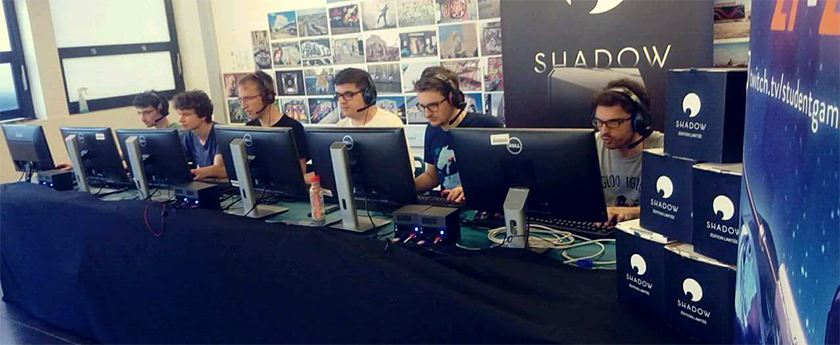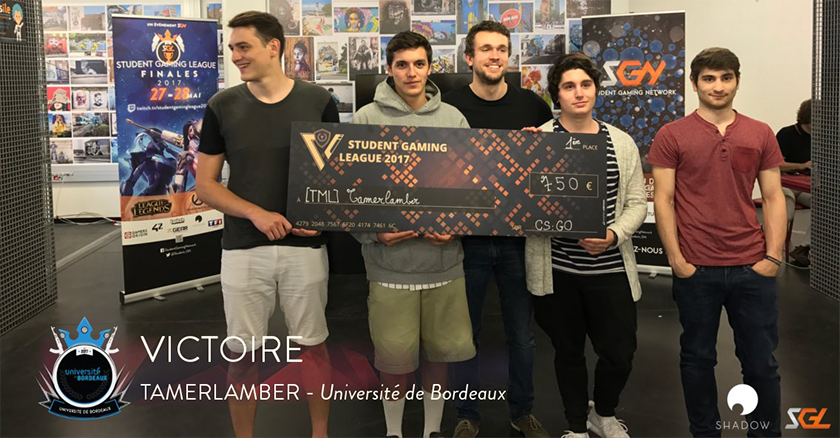From March to May was held in France a huge student Esports competition, organized by the Student Gaming Network. Students from all over the country battled in several games for the title and their name on top of the list.
Now that the tournaments are over, we met with its organizers to learn more about the whole deal.
To start, please introduce yourself and your project
“Hello, I am Pilou, member of the Student Gaming Network, a federation of french student gaming associations.
The association’s goal is to federate students around a common passion: video games. The major event we are organizing for the second year in a row is a national inter-school competition, the Student Gaming League.”

Overwatch finals being played in the School 42
“First on League of Legends, Hearthstone and Counter-Strike:GO, we added Overwatch to the game pool this year. The tournament is mainly played online, with finals organized as offline events. Last year was during an evening in the Paris Meltdown, and this year in the School 42 for a whole week-end.
We are also the instigators of the first European student tournament, in association with our English, Spanish, Portuguese and Italian counterparts: the University eSport Masters.”
How did you discover Toornament?
“Since the first edition, we’ve been using Toornament to manage our tournaments, which we discovered a bit by chance while looking for a platform to organize our competitions on.
After testing several of them, we chose Toornament for its simplicity, its very complete environment, its development perspectives and also because it’s Made in France :)”
What features are you using the most on Toornament?
“On the Organizer‘s side, I think we have quite a complete usage of the platform.
We use Toornament for registrations (which are free), for the whole infrastructure and competition management (structure, results, matches…) and to display tournaments’ information to our spectators (thanks to the widgets and schedules). Tournament management being the core of our project, we really feel at home with these aspects of Toornament.
On the Developer‘s side, we only started tinkering with it this year, but wish to keep pushing forward. Toornament’s API is well-documented and we can see a lot of possibilities using it. Today, we indirectly use it with DoxMatch, our partner platform that directly pushes CS:GO results to the platform.
Unfortunately, we do not make the most of the Participant dashboard yet, which has been evolving a lot for a year, especially for Hearthstone. We are thinking about a way to take advantage of it, for us, but mainly for our next participants.”
Can you develop on your tournaments and their formats?
“The general principle for our competition is as follows: 1 game = 1 evening.
In 2017, it amounted for 102 LOL teams on Mondays, 150+ HS players on Tuesdays, 63 CS:GO teams on Wednesdays and 34 OW teams on Thursdays.
Qualifiers went for 4 to 5 weeks after which the 16 or 32 best participants were selected to play the final bracket.
The Student Gaming League format is a very interesting subject because it tremendously evolved between the two editions, and might just change again for the next one.
On first year, we had a pretty complex system made up of pools dispatched into two leagues with promotion-relegation as qualifiers. It was far from ideal for players, because the qualified teams were not always the best ones, and even worse for us admins because this specific format is not natively available on Toornament. Admins suffered a great deal every evening, and we had to change the format.
After the first competition ended, we wanted to know the motivations of our participants, to have our next edition revolve around what they really wanted.
We realized that two kind of participants emerged: the ones here to play for fun because it was a good reason to gather as students to play with an incentive, and the really competitive ones who registered to go the furthest they could in the tournament.”

Counter-Strike:GO Winners
“That’s why this year, we opted for the Swiss System for all of our games. We wanted a format that would guarantee the best teams would qualify, while allowing more “casual” players to enjoy the tournament too, at least for as long as qualifiers would last. The Swiss System ensures a permanent balancing of matches, to have teams of similar skill level play each other. It prevents massive “stomps” after just 2 or 3 matches, which no one enjoys.
We converted the try, since our weekly team participation went through the roof: on LOL, almost 90% of the participating teams went through the whole qualifier, whereas almost 40% of them dropped last year. Those numbers are to put into perspective with the fact that it’s a long tournament (5 to 10 weeks) and free (no financial involvement needed).
For next year, new challenges are waiting, like reducing the time between matches during tournament nights. First feedbacks from our players are very positive on this new organization, and we can’t wait to play with the new Toornament Structure System to be even more creative when will come the time to create our new format, to fulfill our participants’ needs.”
Could you tell us a bit more about your Discord Bot and your use of the Toornament API?
I will let our developer, Ryan, talk to you about it.
Ryan: “In the Student Gaming Network, we wanted to drastically improve the players’ experience by experimenting with small features to make the difference.
First of all, our tools were using Toornament for three steps during our tournament nights:
- The Check-in
- Match announcement to players
- Results gathering”

Participants checking-in, and the SGL Bot listing the absent ones
“We created a special Check-in, because we wanted our admins to be able to make Captains’ change and manual Check-ins and more importantly, our participants had to Check-in from Discord.
As for match announcements, the idea was to allow players to have their next matches displayed in Discord, with notifications. We had to settle down for a simple command that would allow them to display their next match.
Moreover, results gathering was a huge plus, Toornament doing it automatically for most of our games, we only had to take care of Hearthstone and Overwatch ourselves.
All of these tools were developed during the competition, with very little time and few tests performed.”
What feature would you like to see in Toornament?
“A better Check-in feature would be good, with more flexibility, mostly automatic but with manual input from an admin possible in case it’s needed.
This year, we encountered a limit with disqualified participants. This is an important subject, and we’d like a real “Drop” feature to cut a participant out of a tournament after it has started, to avoid bye matches.”
We would like to thank the SGL Organizers for the time they took to answer our questions, and congratulate them for their massive work and successful tournaments.
Congratulations to the winners and all their opponents too!
See you next year for new exciting tournaments and even more awesome organization!
